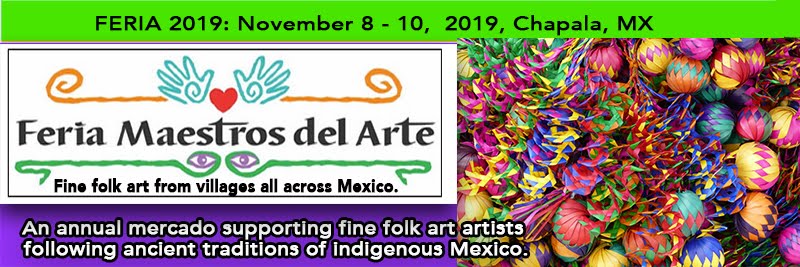 by Marianne Carlson
by Marianne CarlsonFeria Maestros del Arte 2018 is delighted to announce that Marta Turok will be one of our featured speakers at this year’s Feria. Marta is a Mexican applied anthropologist focusing on socio-economic development. Through research, government work, education and advocacy, she has worked to raise the prestige of Mexican handcrafts and folk art and to help artisans improve their economic status. Her work has been recognized with awards from various governmental and non-governmental agencies. Watch our newsletter for more information on the topics Marta will be speaking on during Feria 2018.
 |
| Turok at the Museo de Arte Popular in Mexico (Wikipedia) |
After
WW II, Turok's American parents decided to move to Mexico City where
they started a postcard business, thus growing up bicultural and
bilingual.
Marta
attended Tufts University for her undergraduate degree. The
university allowed undergraduates to design their own course of study,
which she took advantage of as they did not yet have an anthropology
program. Her comprehensive senior thesis was research in Chiapas on the
history and possible meanings of traditional design elements
in Mayan handwoven cloth. This concept was completely new at the time,
and subsequent research proved the concept correct, that the elements
did indeed have meanings at one time, but most have been lost. During
this time, she learned to speak Tzotzil and weave on a back-strap loom.
Turok graduated in 1974, with a degree in anthropology and
socioeconomics. Later, she studied ethnology at the National Autonomous
University of Mexico, graduating in 1978, and in 1996, received a
certificate in marketing from the UC Berkeley.
Instead
of using her research in Chiapas to start an academic career, she opted
to follow a more pragmatic path, helping artisans improve their
economic situation, promoting the cultural value of handcrafts and folk
art, training artisans in marketing and working with collectors, museum
curators and the general public.
 |
| Photo: http://www.eitmedia.mx |
In
1988, she was the executive director of the Dirección General de Culturas Populares (Popular Cultures Bureau), the youngest women named
to a senior post in the Ministry of Education. During her time there, it
grew from 300 to 800 employees, with 17 regional offices. She
established the Mexican Sport Confederation as a national entity; with
supports the preservation of pre-Hispanic sports and games. The agency
also included the publishing of books related to folk art and popular
culture, with topics such as purpura, a dye made from the milk of a female sea snail,
organ grinders and charro (Mexican cowboy) music from northern Mexico. She also developed
a project to preserve weaving and sewing traditions in numerous
indigenous communities, providing fabric, embroidery thread and sewing
needles.
 |
| Photo: Friends of Oaxacan Folk Art |
In 1989, Turok decided to transition from government work to that in the non-profit sector. She founded the Asociacíon Mexicana de Arte y Cultura Popular (AMACUP) or Mexican Association of Popular Art and Culture, which focuses on developing contemporary products using traditional techniques. It also works to ensure that this handcraft production is both economically and environmentally sustainable. It has brought goods to new markets, especially international specialty stores and museum gift catalogs, as well as the major Mexican tourist centers of Cancún, Los Cabos, Cozumel and Puerto Vallarta.
 |
| Add caption |
Turok is still active academically; giving conferences on topics related to Mexican handcrafts and folk art and has taught seminars and courses. In 2016, Turok and Margarita de Orellana became the co-executors of the collection of more than 20,000 artifacts, books and personal items donated by Ruth D. Lechuga to the Franz Mayer Museum.
 Her work has earned her various recognitions: First Place National Contest Award in Marketable Products, First Place Mexico City Export Prize for Crafts Export Enterprises, the Miguel Covarrubias Prize, the Música por la Tierra Prize, AMACUP Marketable Crafts Award, UNESCO de Facto Award for Innovation in Crafts for Mexico and Latin America, and the Van Deren Coke Award of Los Amigos del Arte Popular.
Her work has earned her various recognitions: First Place National Contest Award in Marketable Products, First Place Mexico City Export Prize for Crafts Export Enterprises, the Miguel Covarrubias Prize, the Música por la Tierra Prize, AMACUP Marketable Crafts Award, UNESCO de Facto Award for Innovation in Crafts for Mexico and Latin America, and the Van Deren Coke Award of Los Amigos del Arte Popular.
Marta has written several books including:
Sarapes, Fiestas Mexicanas, El Caracol Purpura: Una Tradicion Milenaria en Oaxaca, Como Acercarse a La Artesania
She has also acted as a contributor to several books including:
Self-Portrait in a Velvet Dress: Frida's Wardrobe Fashion from the Museo Frida Kahlo, Ceramic Trees of Life: Popular Art from Mexico, Living Traditions: Mexican Popular Arts-1992

















